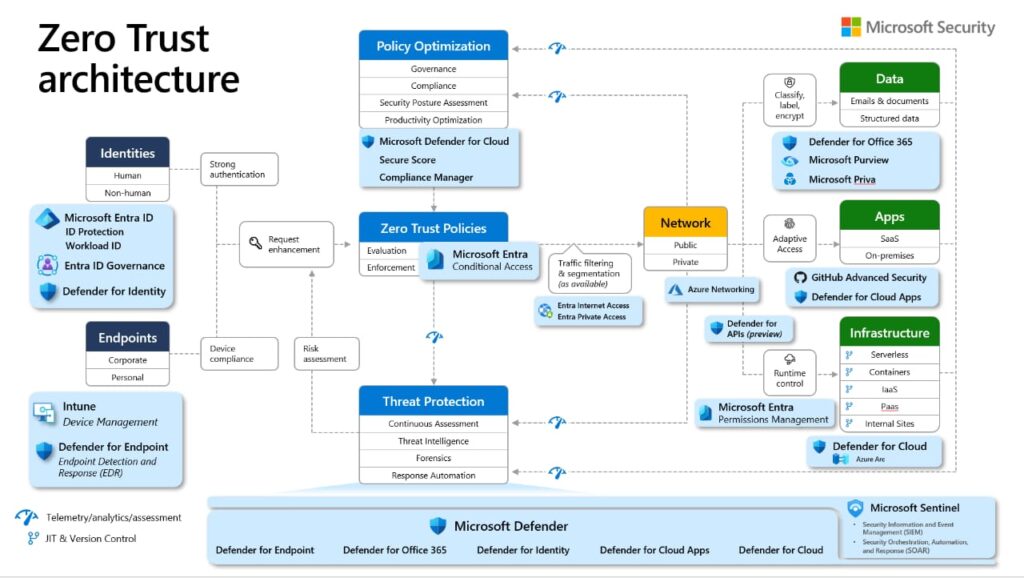
Today, cyber‑attacks are no longer occasional hazards. They’re a predictable threat that risks customer trust, hefty fines, and even business closure. For forward‑looking Spanish companies, adopting Zero Trust Architecture (ZTA) is no longer optional; it’s essential. Here’s why and how to implement it effectively.
🔐 What Is Zero Trust Architecture?
At its core, ZTA means “never trust, always verify” regardless of whether access requests come from within or outside your network perimeter. This modern cybersecurity framework replaces traditional “hard shell/soft centre” models with continuous verification for all users, devices, and applications, even those previously authenticated.
Key Pillars of ZTA:
- Verify explicitly: Every access request is authenticated, authorised, and encrypted, using contextual signals such as identity, device compliance, location, and behavioural indicators.
- Least‑privilege access: Limit permissions to only what’s necessary, using Just‑In‑Time (JIT) or Just‑Enough‑Access (JEA) policies.
- Assume breach: Operate under the assumption of compromise; use micro‑segmentation, encryption, and real‑time threat analytics to contain threats.
Why ZTA Matters for Spanish Businesses
Spain’s vibrant entrepreneurial and startup ecosystem, especially in fintech, proptech, and healthtech, faces two urgent imperatives:
- Protection of sensitive data
Spanish firms fall under GDPR and emerging AI‑specific regulations, whether it’s customer financial records or medical confidences. ZTA’s fine‑grained access controls and continuous monitoring help ensure compliance.
- Greater resilience amidst rising cyber threats
Malicious actors increasingly exploit lateral movement and insider threats. ZTA prevents such escalation by never assuming trust, even if an attacker is within the network.
AI + ZTA = A Cybersecurity Superpower
Integrating AI and Machine Learning amplifies ZTA’s impact:
- Real‑time threat detection: AI detects anomalies like strange login times or device misuse faster and more accurately than manual systems.
- Automated incident response: First suspected breach? AI can automatically isolate devices, disable accounts, or launch forensic audits immediately.
- Adaptive access controls: AI assesses risk based on behaviour, device health, and location, granting access only when it’s safe.
- Streamlined policy management: ML helps set and tweak access rules based on real usage patterns, reducing errors and administrative overhead.
- Predictive security: Going beyond alerts, AI anticipates threats by identifying trends before they escalate.
This synergy is backed by recent research, highlighting AI‑powered identity‑based segmentation that adapts permissions in real‑time, boosting security while maintaining productivity.
Best Practices for Implementation
Here’s a clear roadmap tailored to Spanish enterprises:
- Start with identity and MFA: Implement strong Multi‑Factor Authentication across all systems. Research shows MFA reduces account compromises by over 99%, especially with app‑based tools like Microsoft Authenticator.
- Segment your network: Divide systems into isolated micro‑segments. Compromise can’t cross segments, drastically limiting impact.
- Deploy continuous monitoring and audits: Regularly review access, device posture, and policies. Penetration testing and system logs reveal hidden vulnerabilities and risky permissions.
- Integrate AI‑driven detection and response: Use platforms like Darktrace or Microsoft Defender with AI analytics for real-time monitoring and automated mitigation.
- Enforce least‑privilege policies: Combine JIT and JEA permissions that automatically revoke elevated access post-task.
- Encrypt data everywhere: Encrypt communications and data, whether in use, in transit, or at rest, especially between micro‑segments.
- Train and build awareness: Employees remain the weakest link. Educate team members about the ZTA mindset and enforce best security habits and phishing resistance.
- Evaluate, iterate, mature: ZTA isn’t a one-off project; it’s a cultural shift. Use maturity assessments (e.g., NIST) to evaluate and continuously tighten controls.
Success Stories and ROI
- Microsoft scale: Large organisations reduce incident response time by 50% using Defender and Entra ID in a Zero Trust framework.
- Darktrace: They leverage AI to model “normal” behaviour and swiftly isolate threats, preventing insider attacks undetected by traditional methods.
- Automated MFA effectiveness: MFA reduces the chance of account compromise from leaked credentials by 98–99%.
For Spanish organisations, real benefits include:
- Reduced breach costs through faster detection and containment.
- Less regulatory risk with granular controls and ample forensics.
- Increased trust from clients, partners, and investors.
A Call to Spanish Tech & Business Leaders
In Spain’s digital ecosystem, whether you’re a fintech startup in Madrid or an e-commerce player in Barcelona, Zero Trust is about safeguarding your future. It creates a secure foundation for AI and digital transformation, robust defences against rising cyber threats, and operational resilience, even in hybrid and remote environments.
Yet ZTA isn’t a magic fix. It demands executive sponsorship, cross-team collaboration (IT, development, compliance), and ongoing vigilance.
So, adopt ZTA now or risk falling behind.
Start with identity, enforce MFA, leverage AI for monitoring and response, and build a culture around continuous verification. This isn’t trendy jargon—it’s the modern standard for securing your digital assets, reputation, and competitiveness in an increasingly risky world.
Next Actionable Steps for Spanish Businesses:
- Conduct an identity and device inventory
- Start rolling out enterprise-wide MFA
- Launch micro-segmentation and encryption pilot
- Explore AI‑powered detection response tools
- Initiate regular audits and maturity assessments
Ready to secure your business with Zero Trust? BoznG is here to help with implementation guidance, vendor selection, or Spanish-language resources—just ask.